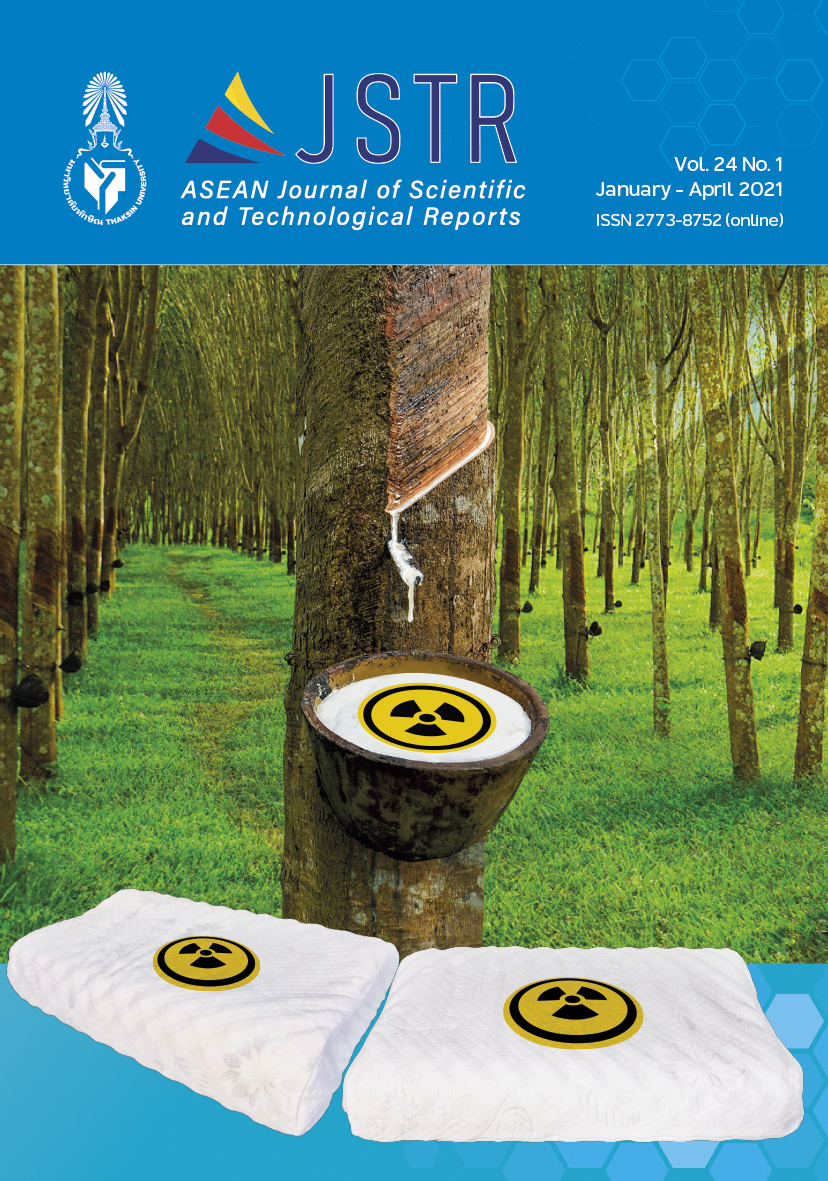Development of Yogurt from Cow and Soybean Milk Supplemented by Rice Bran Hydrolysate with Antioxidant Activity
Main Article Content
Abstract
The objectives of this study were to develop the cow and soybean milk yogurt product supplemented by rice bran hydrolysate with antioxidant activity using the addition of 0.0-1.0 % w/w rice bran hydrolysate, analyze antioxidant activity, and examine sensory characteristics of the yogurt. The study found that 2, 2’-Azino-bis (3-ethylbenzothiazoline-6-sulfonic acid) (ABTS) radical scavenging activity and ferric reducing antioxidant power of cow and soybean milk yogurt trend to be increased based on the increase of rice bran hydrolysate concentration, except for ABTS radical scavenging activity of soybean milk yogurt, which was slightly increased and then constant at 0.75 % of rice bran hydrolysate. Addition of rice bran hydrolysate at concentration of 0.25-1.0 % had no effect on overall acceptability of cow milk yogurt but decreased overall acceptability score of soybean yogurt. Optimum concentration of rice bran hydrolysate with high antioxidant activity in cow and soybean milk yogurt was 1.0 and 0.75 %, respectively. This research indicated that rice bran hydrolysate has a potential use as antioxidant agent supplemented in yogurt for development as functional food.
Article Details

This work is licensed under a Creative Commons Attribution-NonCommercial-NoDerivatives 4.0 International License.
References
Trachoo, N. (2002). Yogurt: The fermented milk. Songklanakarin Journal of Science and Technology, 24(4), 727–737.
Smith, K. J., & Huyser, W. (1987). World distribution and significance of soybean. In J.R. Wilcox (ed.). Soybeans: Improvement, production and uses, 2nd Ed. 1-22. Madison, Wisconsin: American Society of Agronomy.
Moskovitz, J., Yim, M. B., & Chock, P. B. (2002). Free radicals and disease. Archives of Biochemistry and Biophysics, 397(2), 354–359. DOI: 10.1006/abbi.2001.2692.
Qian, Z. J., Jung, W. K., & Kim, S. K. (2008). Free radical scavenging activity of a novel antioxidative peptide purified from hydrolysate of bullfrog skin, Rana catesbeiana Shaw. Bioresource Technology, 99(6), 1690–1698. DOI: 10.1016/j.biortech.2007.04.005.
Wattanasiritham, L., Theerakulkait, C., Wickramasekara, S., Maier, C. S., & Stevens, J. F. (2016). Isolation and identification of antioxidant peptides from enzymatically hydrolyzed rice bran protein. Food Chemistry, 192, 156–162. DOI: 10.1016/j.foodchem.2015.06.057.
Tadakottisarn, S. (2015). Protein products and hydrolyzed protein from jasmine rice bran (Online). Retrieved 7 June 2020, from http://https://www3.rdi.ku.ac.th/?p=20578.
Wiriyaphan, C., Chitsomboon, B., & Yongsawadigul, J. (2012). Antioxidant activity of protein hydrolysates derived from threadfin bream surimi byproducts. Food Chemistry, 132(1), 104–111. DOI: 10.1016/j.foodchem.2011.10.040.
Shori, A.B. (2013). Antioxidant activity and viability of lactic acid bacteria in soybean-yogurt made from cow and camel milk. Journal of Taibah University for Science, 7(4), 202–208. DOI: 10.1016/j.jtusci.2013.06.003.
Thamnarathip, P., Jangchud, K., Nitisinprasert, S., & Vardhanabhuti, B. (2016). Identification of peptide molecular weight from rice bran protein hydrolysate with high antioxidant activity. Journal of Cereal Science, 69, 329–335. DOI: 10.1016/j.jcs.2016.04.011.
Phongthai, S., Lim, S. T., & Rawdkuen, S. (2016). Optimization of microwave-assisted extraction of
rice bran protein and its hydrolysates properties. Journal of Cereal Science, 70, 146–154. DOI:
1016/j.jcs.2016.06.001.
Kim, J. A., Jung, W. S., Chun, S. C., Yu, C. Y., Ma, K. H., Gwag, J. G., & Chung, I. M. (2006). A correlation between the level of phenolic compounds and the antioxidant capacity in cookedwith-rice and vegetable soybean (Glycine max L.) varieties. European Food Research and Technology, 224(2), 259–270. DOI:10.1007/s00217-006-0377-y.
Slavin, M., Cheng, Z., Luther, M., Kenworthy, W., & Yu, L. (2009). Antioxidant properties and phenolic, isoflavone, tocopherol and carotenoid composition of Maryland-grown soybean lines with altered fatty acid profiles. Food Chemistry, 114(1), 20–27. DOI: 10.1016/j.foodchem.2008.09.007.
Charoen, R., Tipkanon, S., & Savedboworn, W. (2017). Production of rice bran protein hydrolysates from traditional Thai rice bran (Plai-Ngahm-Prachinburi). International Food Research Journal, 24(6), 2304–2311.
Chandi, G. K., & Sogi, D. S. (2007). Functional properties of rice bran protein concentrates. Journal of Food Engineering, 79(2), 592–597. DOI: 10.1016/j.jfoodeng.2006.02.018.
Demirci, T., Aktaş, K., Sözeri, D., Öztürk, H.I., & Akin, N. (2017). Rice bran improve probiotic viability in yoghurt and provide added antioxidative benefits. Journal of Functional Foods, 36(1), 396–403. DOI: 10.1016/j.jff.2017.07.019.
Wu, Y. F., Molaison, E. F., Pope, J. F., & Reagan, S. (2005). Attitudes and acceptability of soy-based yogurt by college students. Nutrition & Food Science, 35(3–4), 253–257. DOI: 10.1108/00346650510605649.


